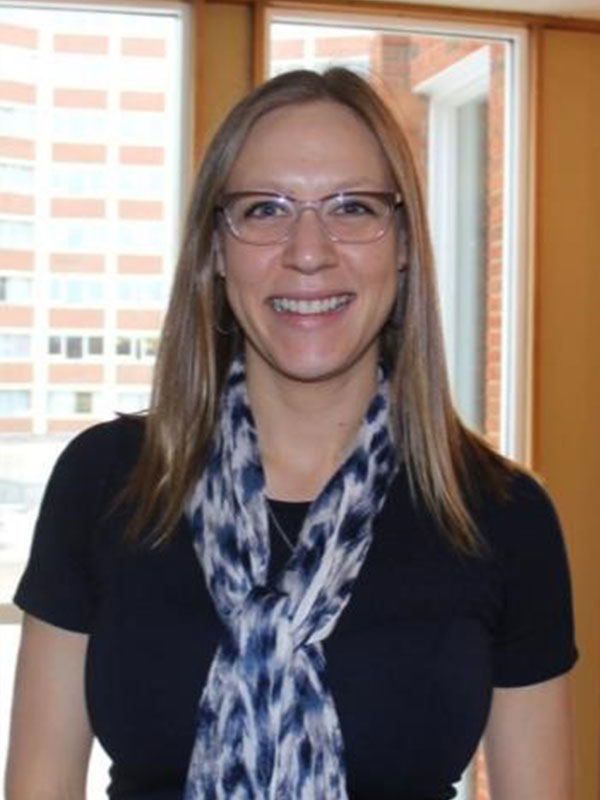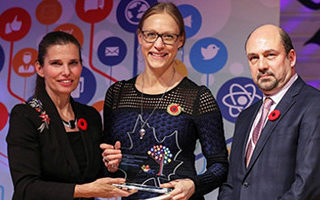Jessica Kolopenuk
2018
Youth Award Winner
Biography:
Jessica Kolopenuk (Cree, Peguis First Nation) is a Ph.D. Candidate in the Department of Political Science at the University of Victoria. Her doctoral project, The Science of Indigeneity: DNA Beyond Ancestry is a study of how, in Canada, genomic biotechnologies are impacting definitions of Indigeneity in the fields of forensic science, biomedical research, and physical anthropology. She identifies productive spaces where Indigenous peoples may intervene to govern the genetic sciences that affect their bodies, territories, and peoples. Jessica recently took up the position of Assistant Professor at the Faculty of Native Studies, University of Alberta (UofA). Over the past two years she has been involved with co-developing the Indigenous Science, Technology, and Society Research and Training Program at the UofA, which aims to support scientific literacy and capacity among Indigenous peoples. Additionally, Jessica is a co-organizer of the Summer internship for Indigenous peoples in Genomics Canada (SING Canada).
Proposal Inspiration:
“The legacy of gender-based violence moves through my family as it does for other Indigenous families who have endured historical and interpersonal traumas associated with colonialism. Less well known to the outside world, though, are the legacies of strength, resilience, and love that are also passed through our generations. The love that I have been given and that which I have for my mom and grandmother, my women relatives, and all those who have experienced physical and sexual violence inspires me to write this proposal. By imagining a productive solution that contributes to ending systems of violence, this proposal is a sign of endurance marking our collective refusal to be altogether defined by victimization. ”
Need/Opportunity for Action:
In Canada there are 1,181 confirmed cases of missing and murdered Indigenous women [1]. Compared to other Canadians, Indigenous women are more likely to experience violence in their lifetime; they are more likely to die as a result of this violence; and their homicides are more likely to go unresolved [1]. International, federal, provincial, and Indigenous research conclude that the victimization of Indigenous women, girls, and 2SLGBTQ (Two Spirit, lesbian, gay, bisexual, transgender, and queer) is systemically linked to Canada’s history of race and gender-based policies of discrimination against Indigenous peoples against Indigenous peoples [2, 3, 4, 5, 6, 7]. Academic research has shown that especially the legal disenfranchisement of Indigenous women and their descendants from their communities via sexist Indian Act registration rules, accompanied by socio-economic marginalization is linked to physical and sexual violence against them [8, 9, 10, 11, 12, 13, 14]. For many Canadians, these are sad realities. For Indigenous peoples, these realities mark the devastating loss of our loved ones who may never come home.
Globally, the analysis and data-banking of DNA is being built into modern systems of governance. As Dr. Frederick Bieber, Advisory Committee member of Canada’s National DNA Data Bank writes, “[m]ost industrialized nations now collect biological samples from crime scenes and from those convicted of serious crimes for entry into government DNA data banks” [15]. Additionally, forensic DNA profiling is used by governments for purposes of “missing persons recovery efforts, and for reunification of human remains in the aftermath of mass disaster or war” [15]. Internationally, large-scale DNA-based identification projects have been designed to, for instance, find the 8960 missing persons killed during the military dictatorship in Argentina from 1976 to 1983 [16]. Likewise, following conflict during the break-up of the former Yugoslavia, the International Commission on Missing Persons (ICMP) was established in 1996 to identify the over 30,000 persons who had gone missing. These projects have set a global precedent: massive coordinated efforts to forensically identify missing and murdered individuals are possible. An Indigenous approach to identifying Missing and Murdered Indigenous Women and Girls (MMIWG) is also possible.
In 2015 the federal government announced the launch of the National Inquiry into Missing and Murdered Indigenous Women and Girls. One year earlier on December 16th, 2014, Canada’s National Missing Persons DNA Program (MPP) was legalized after Bill C-43, The Economic Action Plan 2014 Act, No. 2., was passed by Parliament. Adding three new humanitarian indices to the pre-existing National DNA Data Bank, the MPP is part of a federal government effort to standardize DNA profiling and coordinate the organization of DNA-based data for all missing persons in Canada. Additionally, Canadian policy actors have framed the MPP as both a preemptive and after-the-fact response to violence against Indigenous women and girls [4, 5, 17]. To date, however, there has not been a government-to-government relationship between Indigenous peoples and Canada in the governance of the MPP. Further, the National Inquiry has not targeted forensic DNA policy as an area of research. These are missed opportunities that, if taken, could improve existing policy efforts directed at identifying MMIWG and convicting their offenders.
The fields of science, politics, and law continue to be defined by power imbalances in which Indigenous peoples are not in governing control of policy areas that affect them [18, 19]. Having not designed the MPP, Indigenous organizations have been cautious about its effectiveness. In 2014, the Assembly of First Nations (AFN) warned that it is distrustful of the government’s motivation for collecting and preserving Indigenous people’s DNA [20]. As a question of national policy, the design, operation, and control of the MPP requires ongoing consultation, consent, and collaboration with Indigenous peoples if it is to avoid becoming a form of contemporary paternalism that has historically laced colonial policy-making.
Proposed Action:
Policy solutions aimed at identifying MMIWG and convicting their offenders need to be determined with, by, and for Indigenous peoples, nations, organizations, and families. This proposal, therefore, stops short of offering a prescriptive answer. Instead, it advances a pathway toward the co-production of policy through the cooperation of multiple stakeholders. This approach to policy creation can strengthen the effectiveness of a culturally safe MPP for Indigenous peoples while also strengthening relationships between the federal government and Indigenous peoples. There are some clear initial steps that can be taken to commence this process.
1. Meaningful Indigenous Representation on the National DNA Data Bank Advisory Committee.
The National DNA Data Bank Advisory Committee, appointed by the Solicitor General of Canada, oversees the effectiveness and efficiency of the Data Bank. The Committee is composed of experts in legal, scientific, constabulary, and bioethical fields. There is currently no Indigenous representation on the NDDB Advisory Committee. Given that, in part, the rationale for the creation of the MPP has included consideration of MMIWG, the NDDB Advisory Committee should have Indigenous representation. The percentage of members that are Indigenous included on the Committee ought to be decided in consultation and consent with relevant Indigenous women’s organizations including the Native Women’s Association of Canada, Pauktuutit Inuit Women of Canada, and Les Femmes Michif Otipemisiwak / Women of the Métis Nation.
2. Developing Culturally Relevant DNA Handling Protocols
There are culturally distinct ways of understanding DNA [21, 22]. As late Hopi geneticist Dr. Frank Dukepoo has expressed: for many Indigenous cultures, DNA holds physical and also spiritual significance – genetic material, even when separated from the body, remains part of the whole person [23, 24]. To adapt to advances in DNA-based governance, Indigenous peoples around the world have person [23, 24]. To adapt to advances in DNA-based governance, Indigenous peoples around the world have been developing culturally consistent policies related to the use of DNA. In Aotearoa/ New Zealand, for example, the Guidelines for the Disposal and Retention of Samples and Specimens have been developed: culturally safe Maori protocols for the handling and destruction of DNA [25]. In collaboration with grassroots, provincial/territorial, and national Indigenous organizations, the NDDB should develop optional protocols for Indigenous families who consent to the inclusion of their or their loved one’s DNA into the MPP. This policy change would make Canada a global leader in a reconciliatory approach to forensic DNA policy.
3. Coordinating Research and Practice Among The National Inquiry and the MPP
The National Inquiry into Missing and Murdered Indigenous Women and Girls has been extended to April 2019 at which time it must deliver its final report. Currently, the National Inquiry has not publicly identified the governance of the MPP and the collection, profiling, and data-banking of Indigenous women, girls, 2SLGBTQ and their family members’ DNA as a research priority. As government sponsored forensic policies and practices increasingly move toward the collection and profiling of DNA, Indigenous peoples should not be left behind. In consultation with the NDDB and the National Centre for Missing Person’s and Unidentified Remains (NCMPUR) as well as in its ongoing consultation with institutions, experts, and communities, the National Inquiry should include consideration of forensic DNA approaches to the identification of MMIWG. The Inquiry might consider how current forensic policy can be used or improved to convict offenders.



